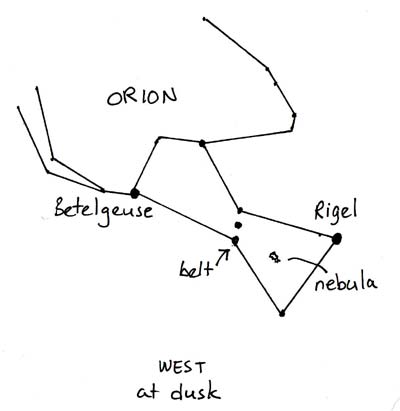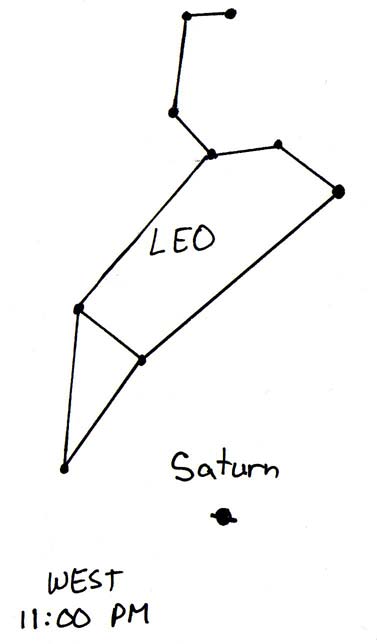
January belongs to one of the most recognizable constellations in the sky, Orion, the Hunter. At dusk, look directly east and see the three distinctive stars of Orion's belt standing straight up from the horizon. Orion's two brightest stars lie to either side of the belt. Betelgeuse, possibly the largest star in our end of the galaxy, is to the left, and Rigel, one of the brightest stars in the sky, is to the right. (Also, ignore the fact that the accompanying illustration says "WEST". It should be EAST. Our artist had been nipping the Romulan ale, and will be disciplined forthwith.)
In between the belt and Rigel is a little group of stars that may look a bit fuzzy. If you look at that area through binoculars, you will see that there is definite fuzziness. This is the Great Orion Nebula, a cloud of dust and gas that glows from the light of new stars that are forming within it.
Also at dusk, or even in the late afternoon, look to the southeast for the "evening star", Venus. You can't miss it. It is the third brightest object in the sky, after the sun and the moon.

Later in the evening, at about 11:00 PM, Venus will have set, and Orion will be standing upright in the south, directly above the brightest star in the night sky, Sirius. Meanwhile, in the east, Leo, the Lion, will have risen. (Again, pay no attention the mislabling of the illustration.) Leo is identifiable by a backwards question mark shape at the front, and a triangle at the tail. Just below Leo, very close to the horizon, will be Saturn. If you are more of a morning person, you will see Leo high in the south at about 5:00 AM, with Saturn below the tail.
**********Cool Thing of the Week: Stellarium
Stellarium is planetarium-style astronomy software program. Unlike charting programs, once you have set your location and time, it will show you the sky as it appears at that moment. During the day, you'll see the sun, and maybe the moon or Venus if they are visible. As dusk approaches, stars will gradually appear, just as they do in the sky. You can customize for things like light pollution, cultural references, constellation display, and more. You can even set your location to be Mars.
Best of all, the software is free and open source. Custom scripts are available at the web site, as is documentation. If you aren't afraid to click and see what happens, though, you will not have any trouble getting the software running without ever looking at the FAQ.
Stellarium is available for Windows, Linux, and Mac.
Stellarium is also available as a portable application which can be stored on, and run from, a USB drive. Portable Stellarium can be run from any Windows computer.
**********Backyard Astronomy updates are now available on Twitter!
BackyardAstro

The Piker Press moderates all comments.
Click here for the commenting policy.